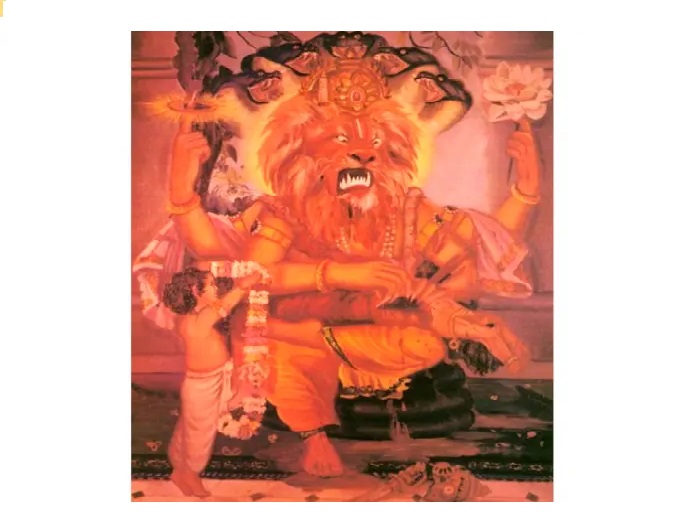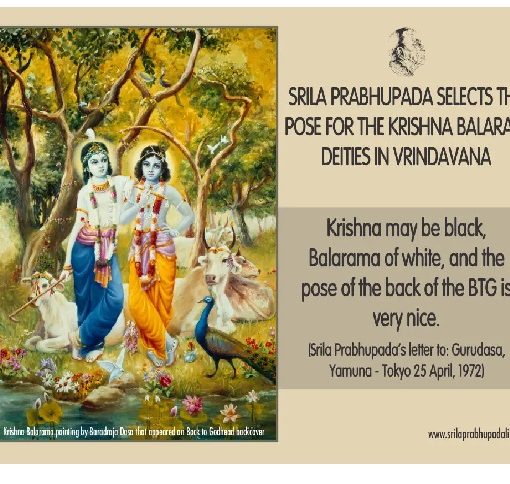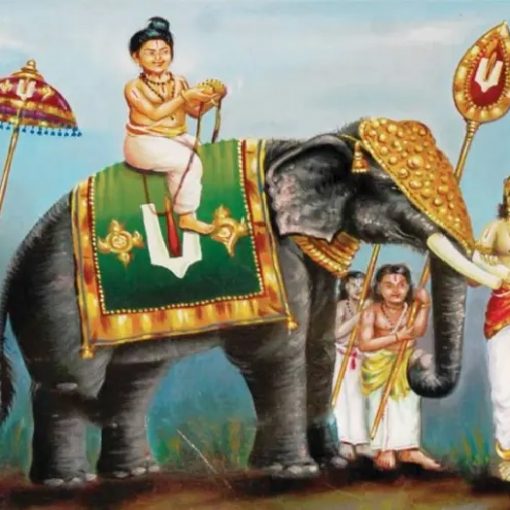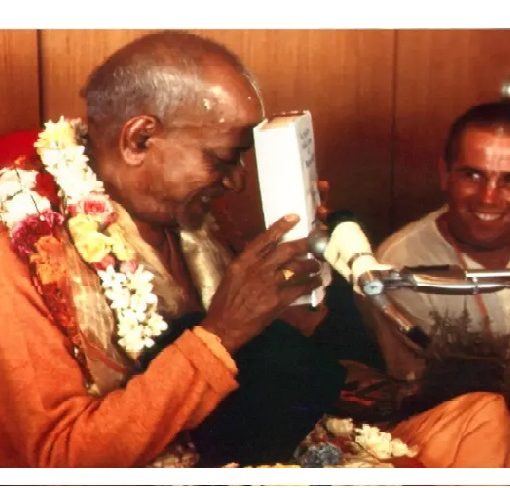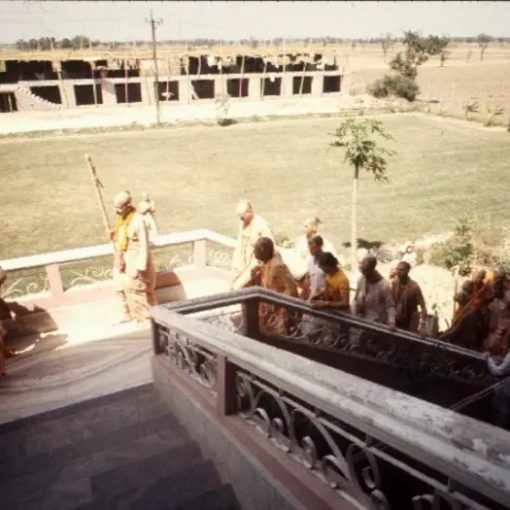Jadurani Dasi : In New York city, 1967, in Srila Prabhupada’s Second Avenue apartment, he asked me to paint a picture of Lord Nrsimhadeva, the half-man, half-lion incarnation of Lord Krishna who appeared many millennia ago. In a print Prabhupada’s disciple Hayagriva Dasa had brought from India, Lord Nrsimhadeva had about ten arms, and He was ripping apart the demon Hiranyakasipu in His lap, tearing out the demon’s intestines. Prabhupada told me to paint only four arms, and he told me the story of Lord Nrsimhadeva.
I was already somewhat familiar with the story because Prabhupada had been giving lectures on Lord Nrsimhadeva and Prahlada, the Lord’s pure devotee, whom the Lord had come to protect. Prabhupada asked me to do a big painting of the killing scene. In fact, he posed for me to demonstrate the proper postures for the action. Imitating Lord Nrsimhadeva, Prabhupada stretched out his hands and then drew them back, spreading his fingers straight a little apart from one another, like delicate claws. I could almost see long lotus nails protruding from his hands. As Prabhupada drew back his hands in a mock menacing way, he glorified Nrsimhadeva: “Your lotus hands have lotus nails with which You rip apart the demon Hiranyakasipu.“
As Prabhupada was pulling his arms back, he opened his eyes wide and crossed them in an inimitable way. I could feel Nrsimhadeva manifesting through His pure devotee. Srila Prabhupada then dropped his arms, and his face at once gained its former composure. In order to remember his expression for the painting, I asked Prabhupada, “Could you do that again?” He did it again, exactly as before. Prabhupada then had Gargamuni (the temple treasure) and Brahmananda (the temple president) act out the death scene to show me the essence of the composition. Prabhupada was the director. He had one of them lie across the other’s lap to mimic the way Hiranyakasipu was pulled into the Lord’s lap and torn apart. I studied the scene and then set about to paint it.
I painted the blood sparingly, applying only a little on the floor and on Hiranyakasipu’s body. Prabhupada looked at the painting and told me, “Paint blood everywhere.” He saw the look of surprise on my face and posed a hypothetical question: “If God is not ferocious, then from where does ferocity come?” So I painted a lot of blood and gore. But I still needed a reference picture for the rug under the Lord’s feet. Prabhupada in his lectures had described the opulence of Hiranyakasipu’s palace. “What does a rug from an opulent Vedic palace look like?” I wondered.
I remembered that there was an Indian picture in Prabhupada’s room, right above where he would write his books or sit and talk with his disciples and guests. It showed Lord Ramacandra, Sita Devi, and Hanuman, with an opulent rug below their lotus feet. I went into Prabhupada’s room and looked high up on the wall trying to see the details of the rug in the picture. I couldn’t really make out all the details without stepping on Prabhupada’s mat to get a closer look. So I started standing on my toes and stretching. I must have looked pretty ridiculous.
Prabhupada, who was sitting on the mat, asked, “What are you doing?“
“I‘m trying to see the print so that I can paint a similar rug in my picture of Lord Nrsimhadeva. But I don’t want to step on your seat.“
“In Krishna’s service,” Prabhupada said humbly, “you can step on my head.“
When the painting was finished, Prabhupada okayed the blue effulgence I’d painted around Lord Nrsimhadeva’s head, although it would generally be perceived as yellowish white.
Soon after I’d completed the Lord Nrsimhadeva painting, my younger sister came to visit the temple. Her disbelief in God was overshadowed only by her criticism of the Hare Krishna movement, which she bad-mouthed to anyone who would listen. I tried to find some common ground with her, so I showed her the Nrsimhadeva painting, hoping she could appreciate it, at least as her sister’s work. As I told her the story, she insisted we should have more compassion for poor Hiranyakasipu. “How could God kill someone,” she asked, “especially the father of His devotee?” I couldn’t answer her, because our relationship was too familiar and she couldn’t accept anything I said. So I brought her to Srila Prabhupada.
Defending his fledgling spiritual daughter, Prabhupada patiently explained to my sister that the father may love everyone but he especially loves his own children. Similarly, God loves everyone, but He shows special favor to His devotees. He explained that Prahlada was a five-year-old devotee and his father had repeatedly tried to kill him and others for their religious beliefs. so Krishna in His fierce form of Lord Nrsimhadeva killed Prahlada’s demoniac father. Prabhupada also told her that being slain by the Lord is not an ordinary thing. Actually, the demon Hiranyakasipu, because the Lord personally killed him, attained a position usually reserved for those who have dedicated their life to austerity and piety. Krishna was doing the demon a favor by killing him.
My sister couldn’t accept anything Prabhupada said. She wasn’t ready for spiritual life. She got up and left in acute frustration, not realizing the benefit she had derived from associating with a pure devotee.
(Jadurani Devi Dasi lives at ISKCON’s Krishna-Balaram temple in Vrndavana, India.)

